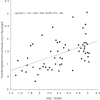Fluoride intake from drinking water and dentifrice by children living in a tropical area of Brazil
- PMID: 19089062
- PMCID: PMC4327232
- DOI: 10.1590/s1678-77572006000500015
Fluoride intake from drinking water and dentifrice by children living in a tropical area of Brazil
Abstract
Objective: To assess fluoride (F-) intake from water and toothpaste by children aged 18 to 36 months and to monitor the F- concentrations in the drinking water system in a tropical city of Brazil.
Methods: Children (n=58) aged 18-36 months, all lifetime residents of Penedo, state of Alagoas, Brazil, participated in this study. Water F- analyses were carried out in 7 different occasions at least a week apart. For 2 days all the water drunk by each child was accounted for. Fluoride intake from water for each child was estimated using the mean F- concentration of water in 7 different occasions. Fluoride intake from toothpaste was estimated by subtracting the recovered post-brushing F- from the original amount placed in the toothbrush. The F- intake from water and toothpaste was estimated by dividing the total amount of F- ingested by the weight of each child.
Results: The mean F- concentration in the drinking water was 0.94 ppm (mean range 0.78-1.1 ppm), which is above the 0.7 ppm recommended for this area of Brazil. Mean total F- intake from water and toothpaste was 0.128 mg F-/Kg Body Weight/day. The daily means of F- intake from water and toothpaste were 0.021 and 0.107 mg F-/Kg Body Weight, respectively. Ninety six percent of children showed F- intake above 0.07 mg F-/Kg Body Weight/day.
Conclusions: Children in Penedo are at risk for developing dental fluorosis due to high F- intake from fluoridated toothpastes. Water fluoridation showed low contribution to the total F- intake. However, high water F- concentrations in the water indicate the need of surveillance of the artificial water fluoridation system.
Objetivos:: determinar a ingestão de flúor (F-) pela água e creme dental em crianças de 18 a 36 meses de idade que moram em uma cidade de clima tropical no Brasil e monitorar as concentrações de F- no sistema de água potável.
Materiais métodos:: participaram deste estudo crianças (n=58), 18-36 meses, todas residentes vitalícias de Penedo (Alagoas), Brasil. As análises de F- em amostras de água foram realizadas em 7 ocasiões diferentes em semanas separadas. Durante 2 dias toda a água bebida por cada criança foi considerada. A ingestão de fluoreto para cada criança foi calculada pela média de flúor na água nas 7 ocasiões diferentes. A ingestão de F- pelo creme dental foi calculada subtraindo a saliva recuperada do expectorado pela quantidade de F- colocada na escova dental. A ingestão de F- de água e pasta de dentes foi calculada dividindo a quantia de F ingerida pelo peso de cada criança.
Resultados:: A concentração média de F- em água potável foi de 0,94 ppm (variando de 0.78-1.12 ppm) estando acima do recomendado para esta área do Brasil que é de 0,7 ppm. A ingestão de F- total (água + creme dental) foi de 0,128 mg de F/Kg peso/dia. As médias diárias de ingestão de F- pela água e creme dental foram de 0,021 e 0,107 mg F-/Kg de peso corporal dia, respectivamente. Noventa que seis por cento das crianças demonstraram ingestão de F- superior a 0,07 mg de F-/Kg peso/dia.
Conclusões:: crianças em Penedo estão sob risco de desenvolver fluorose dental devido a elevada ingestão de F- pelo creme dental fluoretado. Adição de flúor à água de água mostrou baixa contribuição ao flúor total ingerido. Porém, altas concentrações de F- na água indicam a necessidade de vigilância do sistema de fluoretação artificial das águas.
Figures
Similar articles
-
Fluoride ingestion from toothpaste and diet in 1- to 3-year-old Brazilian children.Community Dent Oral Epidemiol. 2007 Feb;35(1):53-63. doi: 10.1111/j.1600-0528.2007.00328.x. Community Dent Oral Epidemiol. 2007. PMID: 17244138
-
Total Fluoride Intake by Children from a Tropical Brazilian City.Caries Res. 2015;49(6):640-6. doi: 10.1159/000442029. Epub 2015 Dec 12. Caries Res. 2015. PMID: 26655142
-
Is the fluoride intake by diet and toothpaste in children living in tropical semi-arid city safe?Braz Oral Res. 2018;32:e26. doi: 10.1590/1807-3107bor-2018.vol32.0026. Epub 2018 Apr 5. Braz Oral Res. 2018. PMID: 29641643
-
The rational use of fluoride toothpaste.Int J Dent Hyg. 2003 Feb;1(1):3-8. doi: 10.1034/j.1601-5037.2003.00001.x. Int J Dent Hyg. 2003. PMID: 16451540 Review.
-
Fluoride exposure from ingested toothpaste in 4-5-year-old Malaysian children.Community Dent Oral Epidemiol. 2005 Oct;33(5):317-25. doi: 10.1111/j.1600-0528.2005.00218.x. Community Dent Oral Epidemiol. 2005. PMID: 16128790 Review.
Cited by
-
Estimated fluoride doses from toothpastes should be based on total soluble fluoride.Int J Environ Res Public Health. 2013 Nov 1;10(11):5726-36. doi: 10.3390/ijerph10115726. Int J Environ Res Public Health. 2013. PMID: 24189183 Free PMC article.
-
Anti-Streptococcal activity of Brazilian Amazon Rain Forest plant extracts presents potential for preventive strategies against dental caries.J Appl Oral Sci. 2014 Apr;22(2):91-7. doi: 10.1590/1678-775720130366. J Appl Oral Sci. 2014. PMID: 24676578 Free PMC article.
-
Fluoride Intake Through Dental Care Products: A Systematic Review.Front Oral Health. 2022 Jun 10;3:916372. doi: 10.3389/froh.2022.916372. eCollection 2022. Front Oral Health. 2022. PMID: 35757442 Free PMC article.
References
-
- Almeida BS, Cardoso VES, Buzalaf MAR. Fluoride ingestion from toothpaste and diet in 1-3-year-old Brazilian children. Community Dent Oral Epidemiol. in press. - PubMed
-
- Brasil. Ministério da Saúde. Secretaria de Atenção à Saúde. Departamento de Atenção Básica. Coordenação Nacional de Saúde Bucal. Projeto SB Brasil 2003: Condições de saúde bucal da população brasileira 2002-2003. Brasília: 2004. 51 Resultados principais.
-
- Burt BA. The changing patterns of systemic fluoride intake. J Dental Res. 1992;71(5):1228–1237. - PubMed
-
- Buzalaf MAR, Granjeiro JM, Damante CA, Ornelas F. Fluctuations in public water fluoride level in Bauru, Brazil. J Public Health Dent. 2002;62(3):173–176. - PubMed
-
- Carvalho JC, Nieuwenhuysen JP, D'Hoore W. The decline in dental caries among Belgian children between 1983 and 1998. Community Dent Oral Epidemiol. 2001;29(1):55–61. - PubMed
LinkOut - more resources
Full Text Sources



